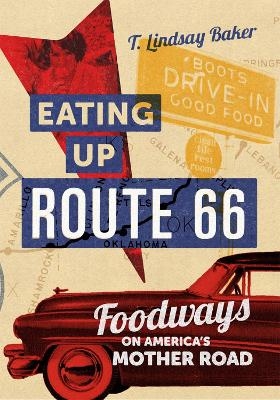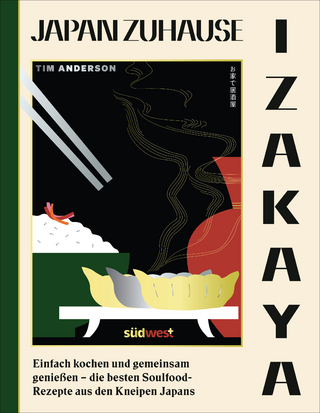
Eating Up Route 66
Foodways on America's Mother Road
Seiten
2022
University of Oklahoma Press (Verlag)
978-0-8061-9069-3 (ISBN)
University of Oklahoma Press (Verlag)
978-0-8061-9069-3 (ISBN)
Grab your hat and your wallet (you’ll probably need cash) and come along for an enlightening trip down America’s memory lane - a westward tour through the nation’s heartland and history, with all the trimmings, via Route 66.
From its designation in 1926 to the rise of the interstates nearly sixty years later, Route 66 was, in John Steinbeck’s words, America’s Mother Road, carrying countless travelers the 2,400 miles between Chicago and Los Angeles. Whoever they were—adventurous motorists or Dustbowl migrants, troops on military transports or passengers on buses, vacationing families or a new breed of tourists—these travelers had to eat. The story of where they stopped and what they found, and of how these roadside offerings changed over time, reveals twentieth-century America on the move, transforming the nation’s cuisine, culture, and landscape along the way.
Author T. Lindsay Baker, a glutton for authenticity, drove the historic route—or at least the 85 percent that remains intact—in a four-cylinder 1930 Ford station wagon. Sparing us the dust and bumps, he takes us for a spin along Route 66, stopping to sample the fare at diners, supper clubs, and roadside stands and to describe how such venues came and went—even offering kitchen-tested recipes from historic eateries en route. Start-ups that became such American fast-food icons as McDonald’s, Dairy Queen, Steak ’n Shake, and Taco Bell feature alongside mom-and-pop diners with flocks of chickens out back and sit-down restaurants with heirloom menus. Food-and-drink establishments from speakeasies to drive-ins share the right-of-way with other attractions, accommodations, and challenges, from the Whoopee Auto Coaster in Lyons, Illinois, to the piles of “chat” (mining waste) in the Tri-State District of Missouri, Kansas, and Oklahoma, to the perils of driving old automobiles over the Jericho Gap in the Texas Panhandle or Sitgreaves Pass in western Arizona. Describing options for the wealthy and the not-so-well-heeled, from hotel dining rooms to ice cream stands, Baker also notes the particular travails African Americans faced at every turn, traveling Route 66 across the decades of segregation, legal and illegal.
So grab your hat and your wallet (you’ll probably need cash) and come along for an enlightening trip down America’s memory lane—a westward tour through the nation’s heartland and history, with all the trimmings, via Route 66.
From its designation in 1926 to the rise of the interstates nearly sixty years later, Route 66 was, in John Steinbeck’s words, America’s Mother Road, carrying countless travelers the 2,400 miles between Chicago and Los Angeles. Whoever they were—adventurous motorists or Dustbowl migrants, troops on military transports or passengers on buses, vacationing families or a new breed of tourists—these travelers had to eat. The story of where they stopped and what they found, and of how these roadside offerings changed over time, reveals twentieth-century America on the move, transforming the nation’s cuisine, culture, and landscape along the way.
Author T. Lindsay Baker, a glutton for authenticity, drove the historic route—or at least the 85 percent that remains intact—in a four-cylinder 1930 Ford station wagon. Sparing us the dust and bumps, he takes us for a spin along Route 66, stopping to sample the fare at diners, supper clubs, and roadside stands and to describe how such venues came and went—even offering kitchen-tested recipes from historic eateries en route. Start-ups that became such American fast-food icons as McDonald’s, Dairy Queen, Steak ’n Shake, and Taco Bell feature alongside mom-and-pop diners with flocks of chickens out back and sit-down restaurants with heirloom menus. Food-and-drink establishments from speakeasies to drive-ins share the right-of-way with other attractions, accommodations, and challenges, from the Whoopee Auto Coaster in Lyons, Illinois, to the piles of “chat” (mining waste) in the Tri-State District of Missouri, Kansas, and Oklahoma, to the perils of driving old automobiles over the Jericho Gap in the Texas Panhandle or Sitgreaves Pass in western Arizona. Describing options for the wealthy and the not-so-well-heeled, from hotel dining rooms to ice cream stands, Baker also notes the particular travails African Americans faced at every turn, traveling Route 66 across the decades of segregation, legal and illegal.
So grab your hat and your wallet (you’ll probably need cash) and come along for an enlightening trip down America’s memory lane—a westward tour through the nation’s heartland and history, with all the trimmings, via Route 66.
T. Lindsay Baker, who holds the W. K. Gordon Chair in Industrial History at Tarleton State University, Stephenville, Texas, is Director of the W. K. Gordon Center for Industrial History, Thurber, Texas, and editor of the Windmiller's Gazette. He is the author of A Field Guide to American Windmills and North American Windmill Manufacturers' Trade Literature: A Descriptive Guide.
| Erscheinungsdatum | 06.10.2022 |
|---|---|
| Zusatzinfo | 50 b&w illustrations, 1 map |
| Verlagsort | Oklahoma |
| Sprache | englisch |
| Maße | 177 x 264 mm |
| Gewicht | 363 g |
| Themenwelt | Sachbuch/Ratgeber ► Essen / Trinken ► Länderküchen |
| Sachbuch/Ratgeber ► Geschichte / Politik ► Regional- / Landesgeschichte | |
| Reisen ► Hotel- / Restaurantführer | |
| Geisteswissenschaften ► Geschichte ► Allgemeine Geschichte | |
| Geisteswissenschaften ► Geschichte ► Regional- / Ländergeschichte | |
| Sozialwissenschaften | |
| ISBN-10 | 0-8061-9069-8 / 0806190698 |
| ISBN-13 | 978-0-8061-9069-3 / 9780806190693 |
| Zustand | Neuware |
| Haben Sie eine Frage zum Produkt? |
Mehr entdecken
aus dem Bereich
aus dem Bereich
70 traditionelle und moderne Rezepte
Buch | Hardcover (2024)
DK Verlag Dorling Kindersley
29,95 €
Einfach kochen und gemeinsam genießen - die besten Soulfood-Rezepte …
Buch | Hardcover (2023)
Südwest (Verlag)
32,00 €


